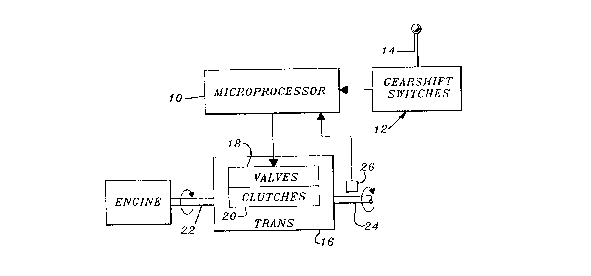Some of the information on this Web page has been provided by external sources. The Government of Canada is not responsible for the accuracy, reliability or currency of the information supplied by external sources. Users wishing to rely upon this information should consult directly with the source of the information. Content provided by external sources is not subject to official languages, privacy and accessibility requirements.
Any discrepancies in the text and image of the Claims and Abstract are due to differing posting times. Text of the Claims and Abstract are posted:
| (12) Patent: | (11) CA 2113289 |
|---|---|
| (54) English Title: | TRANSMISSION SHUTTLE SHIFT DECELERATION METHOD |
| (54) French Title: | METHODE DE DECELERATION POUR TRANSMISSION A INVERSEUR DE MARCHE |
| Status: | Expired and beyond the Period of Reversal |
| (51) International Patent Classification (IPC): |
|
|---|---|
| (72) Inventors : |
|
| (73) Owners : |
|
| (71) Applicants : |
|
| (74) Agent: | BORDEN LADNER GERVAIS LLP |
| (74) Associate agent: | |
| (45) Issued: | 1997-12-16 |
| (22) Filed Date: | 1994-01-13 |
| (41) Open to Public Inspection: | 1994-07-30 |
| Examination requested: | 1994-01-13 |
| Availability of licence: | N/A |
| Dedicated to the Public: | N/A |
| (25) Language of filing: | English |
| Patent Cooperation Treaty (PCT): | No |
|---|
| (30) Application Priority Data: | ||||||
|---|---|---|---|---|---|---|
|
A powershift transmission includes a plurality of
clutches, including a final or directional set of clutches.
The clutches are controlled by electro-hydraulic direct acting
valves and two electro-hydraulic proportional or pressure
modulating valves. The pressure modulating valves modulate
the pressure supplied to the direct acting valves associated
with the three directional clutches. Vehicle deceleration
during a shuttle shift is achieved by releasing
(unpressurizing) all clutches, then gradually pressurizing
only two clutches in the final or directional set.
Transmission automatique comportant plusieurs embrayages, dont un ensemble d'embrayages finals ou directionnels. Les embrayages sont commandés par des électrovalves hydrauliques à action directe et par deux électrovalves hydrauliques proportionnelles ou régulatrices de pression. Les valves modulatrices de pression règlent la pression fournie aux valves à action directe associées aux trois embrayages de marche. La décélération du véhicule pendant un changement de vitesse est effectuée par débrayage (dépressurisation) et par augmentation graduelle de la pression sur seulement deux embrayages dans l'ensemble des embrayages finals ou directionnels.
Note: Claims are shown in the official language in which they were submitted.
Note: Descriptions are shown in the official language in which they were submitted.

2024-08-01:As part of the Next Generation Patents (NGP) transition, the Canadian Patents Database (CPD) now contains a more detailed Event History, which replicates the Event Log of our new back-office solution.
Please note that "Inactive:" events refers to events no longer in use in our new back-office solution.
For a clearer understanding of the status of the application/patent presented on this page, the site Disclaimer , as well as the definitions for Patent , Event History , Maintenance Fee and Payment History should be consulted.
| Description | Date |
|---|---|
| Time Limit for Reversal Expired | 2010-01-13 |
| Letter Sent | 2009-01-13 |
| Inactive: IPC from MCD | 2006-03-11 |
| Inactive: IPC from MCD | 2006-03-11 |
| Inactive: IPC from MCD | 2006-03-11 |
| Inactive: IPC from MCD | 2006-03-11 |
| Letter Sent | 2004-02-06 |
| Grant by Issuance | 1997-12-16 |
| Inactive: Application prosecuted on TS as of Log entry date | 1997-10-09 |
| Inactive: Status info is complete as of Log entry date | 1997-10-09 |
| Pre-grant | 1997-07-22 |
| Notice of Allowance is Issued | 1997-02-18 |
| Application Published (Open to Public Inspection) | 1994-07-30 |
| All Requirements for Examination Determined Compliant | 1994-01-13 |
| Request for Examination Requirements Determined Compliant | 1994-01-13 |
There is no abandonment history.
| Fee Type | Anniversary Year | Due Date | Paid Date |
|---|---|---|---|
| Final fee - standard | 1997-07-22 | ||
| MF (patent, 4th anniv.) - standard | 1998-01-20 | 1998-01-12 | |
| MF (patent, 5th anniv.) - standard | 1999-01-13 | 1999-01-12 | |
| MF (patent, 6th anniv.) - standard | 2000-01-13 | 2000-01-12 | |
| MF (patent, 7th anniv.) - standard | 2001-01-15 | 2001-01-12 | |
| MF (patent, 8th anniv.) - standard | 2002-01-14 | 2002-01-11 | |
| MF (patent, 9th anniv.) - standard | 2003-01-13 | 2003-01-10 | |
| MF (patent, 10th anniv.) - standard | 2004-01-13 | 2003-12-22 | |
| MF (patent, 11th anniv.) - standard | 2005-01-13 | 2004-12-21 | |
| MF (patent, 12th anniv.) - standard | 2006-01-13 | 2005-12-30 | |
| MF (patent, 13th anniv.) - standard | 2007-01-15 | 2006-12-20 | |
| MF (patent, 14th anniv.) - standard | 2008-01-14 | 2007-12-18 |
Note: Records showing the ownership history in alphabetical order.
| Current Owners on Record |
|---|
| DEERE & COMPANY |
| Past Owners on Record |
|---|
| KEVIN LEE VAUGHTERS |